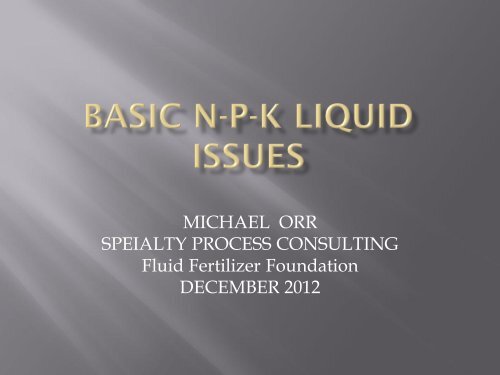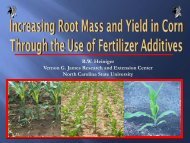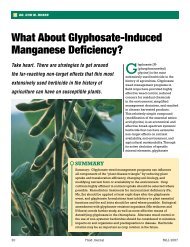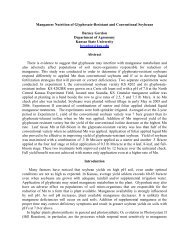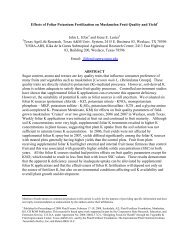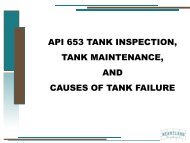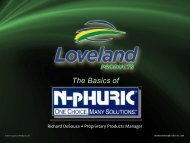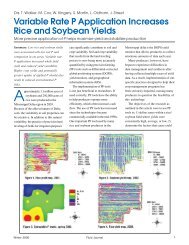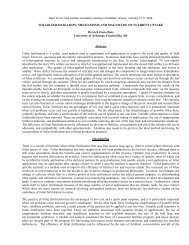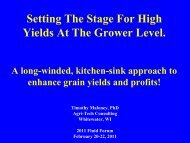M. Orr - Fluid Fertilizer Foundation
M. Orr - Fluid Fertilizer Foundation
M. Orr - Fluid Fertilizer Foundation
Create successful ePaper yourself
Turn your PDF publications into a flip-book with our unique Google optimized e-Paper software.
MICHAEL ORR<br />
SPEIALTY PROCESS CONSULTING<br />
<strong>Fluid</strong> <strong>Fertilizer</strong> <strong>Foundation</strong><br />
DECEMBER 2012
• Materials<br />
• Cold vs. hot mixing<br />
• Potential issues with liquid blends<br />
• Example
• Water<br />
• Urea Ammonium-Nitrate (UAN)<br />
• Ammonium Polyphosphate (10-34-0)<br />
• Solution grade muriate of potash (0-0-62)
• Wet process phosphoric acid<br />
• Potassium thiosulfate (KTS)<br />
• Aqua ammonia<br />
• Urea<br />
• Ammonium Thiosulfate (12-0-0-26(S))
• Desired salting out temperature<br />
• Storage temperature desired<br />
• Impurities in materials or storage tanks<br />
• Polyphosphate content
• Temperature of raw materials.<br />
• Colder materials take longer to mix.<br />
• Potash cools solution on addition.<br />
• Can use hot water to speed mixing times.<br />
• Salting out temperature of final product.<br />
• Higher salting out temperature requires longer mix<br />
times.
agitator<br />
water UAN-32 10-34-0<br />
KCl<br />
mix<br />
tank<br />
scale<br />
circulation<br />
pump<br />
Cold Mixing<br />
product<br />
storage<br />
Sequence
• Heat supplied by chemical reaction:<br />
• Strong acid, phosphoric acid (merchant grade)<br />
• Strong base, aqua ammonia or anhydrous<br />
• Must use 10-34-0 to supply polyphosphate<br />
• Without potash,<br />
a blend requires 25% of P 2 O 5 from 10-34-0<br />
• With potash<br />
must have 35 - 45% of P 2 O 5 from 10-34-0
• No external heat source required.<br />
• Faster mixes.<br />
• Cheaper mixes made using merchant<br />
grade phosphoric acid and aqua ammonia<br />
than just 10-34-0.<br />
• Can use dry urea as N source since heat<br />
will help dissolve urea.
aqua<br />
water<br />
UAN-32<br />
10-34-0<br />
0-54-0<br />
agitator<br />
KCl<br />
mix<br />
tank<br />
scale<br />
circulation<br />
pump<br />
Hot Mixing<br />
product<br />
storage<br />
Sequence
Cold mixing steps:<br />
1. Determine application rate.<br />
2. Calculate N:P:K ratio.<br />
3. Convert fractional ratio to integer ratio.<br />
4. Refer to table to determine grade.<br />
5. Calculate formula.<br />
6. Calculate application rate.
Desired application rate:<br />
• N 60 lbs./acre<br />
• P 2 O 5 40 lbs./acre<br />
• K 2 O 40 lbs./acre<br />
Using UAN-32, 10-34-0, 0-0-62 & water
Divide smallest rate into other rates<br />
• N: 60/40 = 1.5<br />
• P 2 O 5 : 40/40 = 1.0<br />
• K 2 O: 40/40 = 1.0<br />
Ratio is 1.5 : 1 : 1
In this case, multiply all numbers by 2<br />
• 1.5 x 2 = 3<br />
• 1.0 x 2 = 2<br />
• 1.0 x 2 = 2<br />
The resulting ratio is 3 : 2 : 2
Refer to Cold Mix Table<br />
• For 3:2:2 the grade that will have a salt out<br />
temperature of 32ºF is:<br />
• 8.7% N<br />
• 5.8% P 2 O 5<br />
• 5.8% K 2 O
Multiply all percentages by 20<br />
• N: 8.7 x 20 = 174 lbs./ton<br />
• P 2 O 5 : 5.8 x 20 = 116 lbs./ton<br />
• K 2 O: 5.8 x 20 = 116 lbs./ton
10-34-0:<br />
• (116 lbs./ton)/0.34 = 341 lbs. of 10-34-0/ton<br />
UAN-32:<br />
• N required from UAN-32 after 10-34-0<br />
= 174 – (341 x 0.10) = 139.9 lbs.<br />
• Weight/ton = 139.9/0.32 = 437 lbs./ton<br />
0-0-62:<br />
• 116/0.62 = 187 lbs./ton
Subtract total weight of other materials from 2,000<br />
lbs.<br />
2,000 – (341+437+187)<br />
= 1,035 lbs. Water/ton
For 8.7 - 5.8 - 5.8 grade liquid:<br />
Water 1,035 lbs.<br />
0-0-62 187 lbs.<br />
10-34-0 341 lbs.<br />
UAN 437 lbs.<br />
Total = 2,000 lbs.
Determine lbs. blend/acre<br />
60/0.087 = 690 lbs. blend/acre<br />
Determine gallons/acre<br />
Assume most blends weigh 10 lbs./gallon<br />
(690 lbs./acre)/(10 lbs./gallon) = 69 gpa
Desired application rate:<br />
• N 25 lbs./acre<br />
• P 2 O 5 75 lbs./acre<br />
• K 2 O 25 lbs./acre<br />
Using Phos acid, aqua, UAN-32,<br />
10-34-0, 0-0-62 & water
Divide smallest rate into other rates<br />
• N: 25/25 = 1<br />
• P 2 O 5 : 75/25 = 3<br />
• K 2 O: 25/25 = 1<br />
Ratio is 1 : 3 : 1
Refer to Hot Mix Table<br />
• For 1:3:1 the grade that will have a salt<br />
out temperature of 32ºF is:<br />
• 7.4 % N<br />
• 22.2 % P 2 O 5<br />
• 7.4 % K 2 O
Multiply all percentages by 20<br />
• N: 7.4 x 20 = 148 lbs./ton<br />
• P 2 O 5 : 22.2 x 20 = 444 lbs./ton<br />
• K 2 O: 7.4 x 20 = 148 lbs./ton
Need to have 45% of P 2 O 5 from 10-34-0<br />
Total P 2 O 5 x 0.45 = weight of polyphosphate<br />
P 2 O 5<br />
444 x 0.45 = 200 lbs.<br />
10-34-0 is 70% polyphosphate so:<br />
200/0.70 = 286 lbs. of P 2 O 5 from 10-34-0<br />
Now calculate Lbs./ton of 10-34-0<br />
286/34 = 841 lbs./ton
Need a total of 444 lbs. P 2 O 5<br />
10-34-0 supplies 286 lbs. P 2 O 5<br />
444 – 286 = 158 lbs. P 2 O 5 Lbs./ton<br />
158/0.54 (54% acid) = 293 lbs. Phos acid
Need to ammoniate acid to N: P 2 O 5 ratio<br />
of 3:10.<br />
Phos acid added at 158 lbs./ton<br />
158 x 0.3 = 47.4 lbs. N<br />
Lbs. Aqua/ton<br />
47.4/0.2 = 237 lbs aqua/ton
Total N – (N from aqua + N from 10-34-0)<br />
148 – [47.4 +(841 x 0.1)] = 16.5 lbs. N<br />
Lbs. UAN/ton<br />
16.5/0.32 = 52 lbs. UAN/ton
Require 148 lbs K 2 O per ton<br />
148 lbs./0.62 = 238 lbs. KCl/ton
2000 lbs. – (weight of other materials)<br />
2,000 – (841 + 293 + 237 + 52 + 238)<br />
= 339 lbs. Water/ton
For 7.4 – 22.2 – 7.4 grade liquid:<br />
Water 339 lbs.<br />
Phos acid 293 lbs.<br />
Aqua 237 lbs.<br />
UAN 52 lbs.<br />
10-34-0 841 lbs.<br />
0-0-62 238 lbs.<br />
Total = 2,000 lbs.
• MAXIMUM N-P-K IN SOLUTION 35%<br />
• MICROS MAXIMUM IN SOLUTION 6%<br />
• POLY/ORTHO PHOSPHATE BLENDS<br />
• LOW SALT BLENDS 35% DEPENDING ON<br />
RATIO
100%<br />
P 2 O 5<br />
Contours = (N + P 2 O 5 + K 2 O)<br />
that remain in solution at<br />
32°F<br />
Crystallization zones<br />
1:1:0<br />
50<br />
1:2:0<br />
60<br />
1:3:0<br />
70<br />
31<br />
37<br />
33<br />
39<br />
35<br />
80<br />
41<br />
90<br />
3:6:1<br />
1:2:1<br />
3:9:1<br />
10<br />
20<br />
30<br />
acid<br />
1:3:1<br />
solutions<br />
10-34-0, UAN-32,<br />
Muriate of Potash<br />
and water at 32°F<br />
system<br />
40<br />
50<br />
40<br />
29<br />
27<br />
3:3:1<br />
1:2:2<br />
1:3:3<br />
60<br />
10<br />
2:1:0<br />
30<br />
4:1:0<br />
20<br />
25<br />
23 6:3:2<br />
3:1:1<br />
21<br />
19<br />
17<br />
1:1:1 1:2:3<br />
KCl<br />
KNO 3 2:1:2<br />
3:1:3<br />
1:1:3<br />
2:1:6<br />
70<br />
80<br />
90<br />
100<br />
%N<br />
90<br />
80<br />
70<br />
15<br />
60<br />
50<br />
40<br />
30<br />
20<br />
17<br />
10<br />
100%<br />
K 2 O
NO WITH ACIDS<br />
SIGNS REDDISH/BROWN GAS<br />
NERVE GAS/DEADLY<br />
NITRATE NOT HIGHLY SOLUBLE WITH POTASSIUM<br />
WILL COMPETE WITH OTHER ANIONS IN SOLUTIONS<br />
KEEP IN MIND WITH UAN SOLUTION MIXING
Good Quality Micro Products Improve Blending<br />
Pay Attention to Order Of Addition, pH, etc<br />
Be Careful Of Point Introduction Precipitation<br />
Make Sure Adequate Mixing Time Prior To Loading<br />
Truck Mixing Of Blends
• HAVE ALL PERTINENT SHIPPING<br />
INFORMATION, BOLs, DOT requirement, etc.<br />
• REVIEW AND UNDERSTAND MSDS AND<br />
RMP/PSM REQUIREMENTS<br />
• HAZARDOUS MATERIALS RECEIVING
• Make Sure Inbound Transport Is Connected to<br />
the Correct Storage Tank<br />
• Open All Appropriate Valves and Close Others<br />
• Contain All Leaks<br />
• Check Tank Inventory Prior To Transfer<br />
• Wear Proper PPE<br />
• Close All Appropriate Valves Upon Completion<br />
Of Transfer<br />
• Complete All Documentation and Record Ending<br />
Inventory
• Zinc<br />
• Manganese<br />
• Copper<br />
• Iron<br />
• Magnesium<br />
(Mg)<br />
• Boron
• Zinc Oxide, Zn Sulfate, Zinc Citrate, and Zinc EDTA<br />
• Manganese Dioxide, Manganese Sulfate, and<br />
Manganese EDTA<br />
• Copper Sulfate, Copper Citrate, and Copper EDTA<br />
• Ferrous Sulfate, and Iron EDTA<br />
• Manganese EDTA<br />
• Boric Acid
• Wide range of blends possible!<br />
• Pull away from the pack!<br />
Use soil and tissue tests to optimize<br />
your liquid program to the crop.<br />
QUESTIONS


